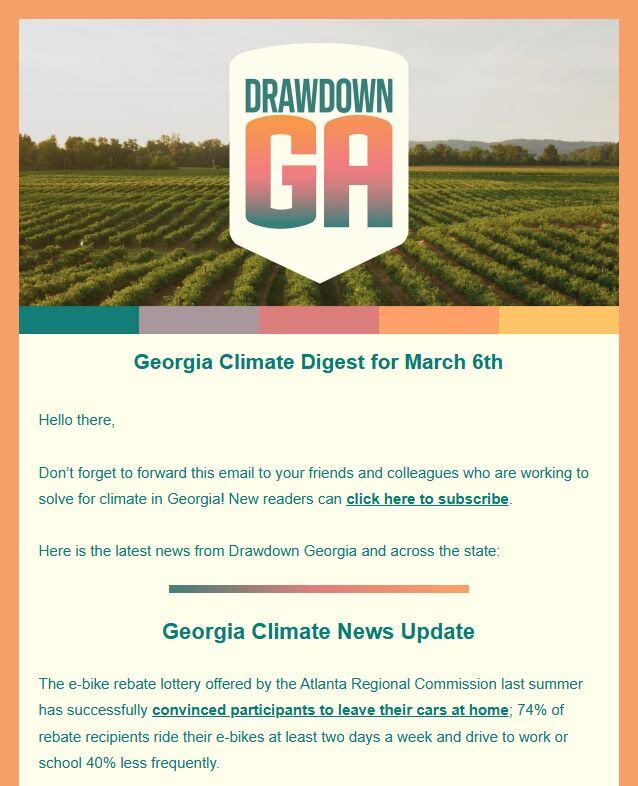The Benefits of Recycling and Waste Management
Recycling can reduce greenhouse gas emissions because recycling is often less energy-intensive than producing new items. This solution considers increases in recycling at the household level; increases in industrial and commercial recycling; and a focus on increasing paper recycling.
Access Recycling Resources from Drawdown Georgia
Market Readiness And Available Technology
The technologies used in Recycling and Waste Management are mature and market-ready. According to Project Drawdown®, Europe achieves paper recycling rates as high as 75% and the United States currently achieves paper recycling rates of 68%. Other recyclable materials have commercial and market presence in the United States, including plastics (9%) and glass (25%).
What Is The Potential Impact Of Recycling and Waste Management?
The Drawdown Georgia research team estimates that Georgia could reduce emissions by one megaton (Mt) of CO2e by recycling at least 20% of currently disposed paper waste annually.
What is the Carbon Emissions Reduction Potential by 2030?
Achievable reduction potential is derived by taking the technical reduction potential, outlined below, and developing a more realistic forecast that takes current rates of deployment, market constraints, and other barriers into consideration.
For recycling, the Drawdown Georgia research team has calculated the achievable reduction potential to be 1.72 Mt of CO2e.
What Is the Upper Limit of Carbon Emissions Reduction Potential?
Technical reduction potential reflects the upper limit of emissions reductions for this solution without regard to the constraints that exist in the real world, such as economic or political considerations.
For recycling, the Drawdown Georgia research team has calculated the technical reduction potential to be 7.7 Mt.
Progress on Recycling in Georgia
The City of Atlanta and many other cities in Georgia have active recycling programs. Other organizations, such as the Center for Hard to Recycle Materials (CHaRM), improve recycling rates by spreading the word and facilitating the procurement of high-quality recyclable materials. Plastic recycling start-ups such as Nexus LLC demonstrate opportunities for the commercialization of plastic recycling in Georgia.
According to the Georgia Recycling Coalition, Georgia is second in the nation in terms of end-use recycling material infrastructure, with over 120 manufacturers using recovered materials in their products. Some examples are the pulp/paper industry and the carpet industry, which accepts about one-third of the PET plastic bottles that are recycled in the US.
U.S.-level recycling data is also available through the EPA.
Challenges in Scaling Recycling in Georgia
Recycling is one of the more widely adopted sustainable practices among Georgia residents. According to a Georgia Tech/UGA survey of nearly 1,700 state residents, funded by Drawdown Georgia, over half of respondents (54%) stated that they recycle "always" or "most of the time." This indicates a general awareness and willingness to engage in recycling efforts.

However, a notable portion (24%) admitted to recycling rarely or never. This suggests potential barriers such as a lack of accessibility to recycling programs, insufficient infrastructure, or a need for greater awareness about the benefits of recycling and proper waste sorting.
How Reliable Is Our 2030 Estimate For This Drawdown Georgia Climate Solution?
The carbon emissions reduction potential is high. According to a 2005 municipal solid waste (MSW) composition study by the Georgia Department of Community Affairs, Georgians annually throw away approximately 1.9 million tons of paper, 1 million tons of plastics, 0.36 million tons of metal, and 0.24 million tons of glass. This study also indicated that Georgia generally lags behind the United States in terms of recycling rates, especially in paper recycling.
Significant energy savings can be achieved by more widespread recycling. For example, one ton of recycled plastic saves approximately 5,800 kWh of energy. Preliminary analysis using assumed current recycling rates equal to the U.S. averages for different recyclable materials and increasing to 65% for plastics, glass, and metals and 90% for paperboard by 2030, indicates carbon reduction potential greater than the 1 Mt CO2 threshold.
Cost Competitiveness
Recycling may not be a highly cost-competitive solution, based on global Project Drawdown® estimates. In addition, current market conditions are not necessarily favorable for increased recycling (e.g., the abundance of cheap natural gas in the United States has formed an economic barrier against increased plastics recycling).
Beyond Carbon Attributes
Co-benefits: Benefits from this solution relate to environmental and public health from the improvement in air quality and water quality associated with waste diversion from landfills. Additional benefits would likely emerge from the creation of jobs associated with expanded/upgraded recycling services.
Establishing alternative waste management and recycling programs could create a steady supply of recycled materials that could be used in promoting new business and construction startups, products, and services. For example, using recyclable plastics in house insulation or reclaimed fibers in new textiles and clothes. This could foster the creation of new local economies for recycled/reclaimed products, which would promote jobs and local economic development.
Co-costs: There are concerns relating to the siting of additional recycling facilities, which may be disproportionately located in low-income communities, negatively impacting air quality in those areas.



